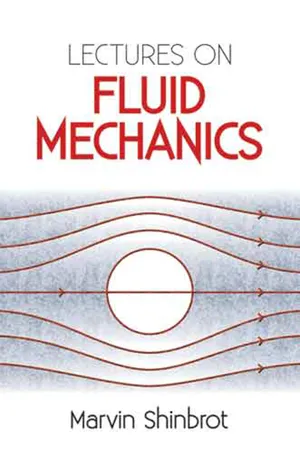
This is a test
- 240 pages
- English
- ePUB (mobile friendly)
- Available on iOS & Android
eBook - ePub
Lectures on Fluid Mechanics
Book details
Book preview
Table of contents
Citations
About This Book
A readable and user-friendly introduction to fluid mechanics, this high-level text is geared toward advanced undergraduates and graduate students. Mathematicians, physicists, and engineers will also benefit from this lucid treatment.
The book begins with a derivation of the equations of fluid motion from statistical mechanics, followed by examinations of the classical theory and a portion of the modern mathematical theory of viscous, incompressible fluids. A considerable part of the final chapters is devoted to the Navier-Stokes equations. The text assumes a familiarity with functional analysis and some complex variables, and it includes an especially valuable discussion of the modern function theoretic approach to solving partial differential equations. Numerous exercises appear throughout the text.
The book begins with a derivation of the equations of fluid motion from statistical mechanics, followed by examinations of the classical theory and a portion of the modern mathematical theory of viscous, incompressible fluids. A considerable part of the final chapters is devoted to the Navier-Stokes equations. The text assumes a familiarity with functional analysis and some complex variables, and it includes an especially valuable discussion of the modern function theoretic approach to solving partial differential equations. Numerous exercises appear throughout the text.
Frequently asked questions
At the moment all of our mobile-responsive ePub books are available to download via the app. Most of our PDFs are also available to download and we're working on making the final remaining ones downloadable now. Learn more here.
Both plans give you full access to the library and all of Perlego’s features. The only differences are the price and subscription period: With the annual plan you’ll save around 30% compared to 12 months on the monthly plan.
We are an online textbook subscription service, where you can get access to an entire online library for less than the price of a single book per month. With over 1 million books across 1000+ topics, we’ve got you covered! Learn more here.
Look out for the read-aloud symbol on your next book to see if you can listen to it. The read-aloud tool reads text aloud for you, highlighting the text as it is being read. You can pause it, speed it up and slow it down. Learn more here.
Yes, you can access Lectures on Fluid Mechanics by Marvin Shinbrot in PDF and/or ePUB format, as well as other popular books in Physical Sciences & Physics. We have over one million books available in our catalogue for you to explore.
Information
PART I
SETTING THE SCENE
Introduction
THE SCIENCE of mechanics begins, and properly ends, as a part of physics. But I believe there is a stage in the development of each branch of mechanics where it is (or should be) part of mathematics. At least one branch—particle mechanics—has passed through its period as mathematics and has become physics again. But fluid mechanics and, more generally, all continuum mechanics have really just begun their development as mathematical sciences. There is much to be done before continuum mechanics can be considered as having reached such a state of symmetry and elegance that the mathematician can turn it back to the physicist for its final development.1
Classical particle mechanics began its transition from physics to mathematics with Newton’s treatment of gravitation. Before Newton’s time, the basic (and basically physical) ideas such as force, mass, uniform velocity and acceleration had to be explored. In addition, much fundamental physical data had to be collected: the distance of the moon from the earth and the curves traced out by the planets are examples.
Although there is some doubt2 as to how far Newton carried the mathematical development of particle dynamics, there can be no question that the work he did there was mathematical in nature. In the theory of gravitation, Newton had to begin with Kepler’s empirical conclusions about the orbits of the planets and then derive these same conclusions from a set of hypotheses about the world. This process, as we now understand it, involves three steps. In order to see exactly where it becomes mathematics and not physics, it is well to enumerate these steps clearly.
(i) First, the idea is needed that force and acceleration (whatever they are!) are proportional. This fact is, of course, the famous “second law” of Newton:

Although this idea will eventually develop into the mathematical equations of motion of the gravitating system, it is important to notice that the validity of (0.1) is a physical fact. There is no intrinsic mathematical reason whatever why this law should not read differently. Indeed,...
Table of contents
- Cover Page
- Title Page
- Copyright Page
- Dedication
- Preface
- Contents
- PART I SETTING THE SCENE
- Part II A TASTE OF THE MODERN THEORY
- Index
- Back Cover